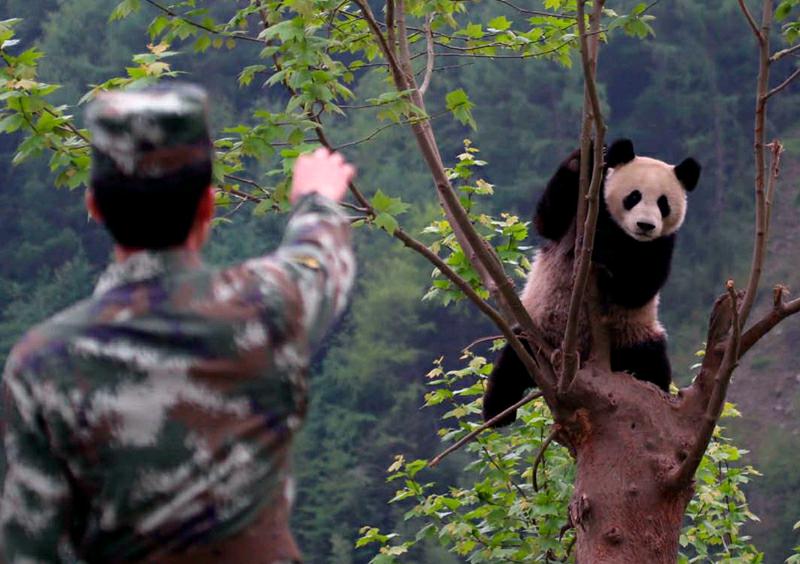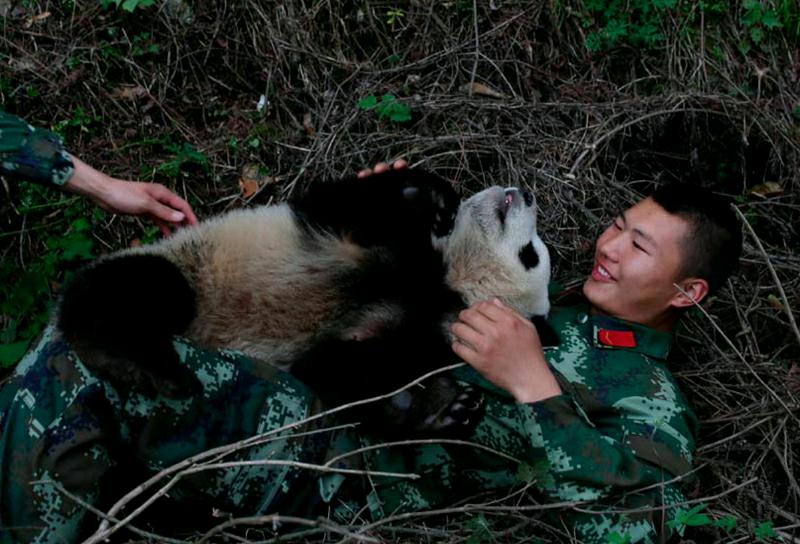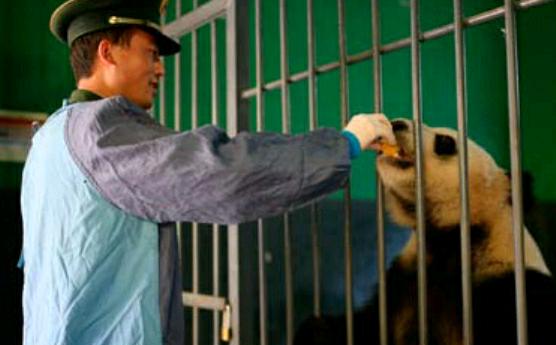Under Good Protection
by+Cheng+Xueli
Reunion
May 11, 2016, was a bittersweet day. Eight years after a catastrophic earthquake struck Wenchuan, Sichuan Province, on May 12, 2008, China Giant Panda Center in Wolong Shenshuping Base under the China Research and Conservation Center for the Giant Panda welcomed home some displaced pandas that had been moved because of the quake.
It was a big day for Wang Gang, an officer with the armed police guarding the forest, and panda Su Lin, who were reunited after eight years of separation.
Wang met Su Lin the day the earthquake rocked Wenchuan. He and some colleagues were assigned to patrol the research center to guard two pandas, Tuan Tuan and Yuan Yuan, who were on their way to Taiwan as gifts.
But their plans changed: At 2:28 p.m., a magnitude-8 earthquake struck, shaking the earth and rocking the mountains. Wang and his colleagues ran into the surrounding mountains and rescued four giant pandas and 14 young pandas. Four – Su Lin, Yuan Yuan, Xi Xi, and Mao Mao – were missing. Yuan Yuan was found four days after the quake. Wang Gang found Su Lin injured in a brook blocked by a landslide. In a few days, every lost panda was found amidst aftershocks and rainstorms.
The eco-environment around the research and conservation center was severely damaged. More than 60 giant pandas were transferred out of the area, with 32 sent to other domestic panda centers and the rest to an emergency center in Yaan, Sichuan. Su Lin hadnt seen her guardian in eight years.
Primary Mission
The primary mission of the armed police at Wolong is to safeguard the habitat of pandas and protect its diverse population of wild animals and plants.
For giant pandas, their natural habitat previously shrunk on a massive scale during the last glacial maximum 18,000 years ago. Some 5,000 years ago, giant pandas coexisted with man in Laibin in todays Guangxi Zhuang Autonomous Region, as evidenced by unearthed bones and pottery shards. Archaeological discoveries have shown that giant pandas shared their habitat with northern animals such as raccoon dogs and badgers in todays Xichuan, Henan Province. The development of agriculture and population booms in the areas at low altitudes, however, further eroded forests and bamboo grooves, crippling the population of giant pandas in most places across the country, leaving just little available habitat for them, concentrated in the mountains of Qinling, Minshan, Qionglai, the Greater and Lesser Xiangling, and Daliang, between 1,500 and 3,000 meters above sea level – land that is not arable.
It should go without saying that protecting the remaining habitat of the giant panda now is of grave importance. The more the area shrinks, the chances of pandas getting attacked by natural enemies and mankind grow, while their abilities to find food and mate healthily shrink.
For giant pandas, the direct threat from natural enemies is relatively low. The greater threats are human activities obstructing their habitats: logging, plowing, bamboo shoot cutting, herb gathering, and hunting – even of other animals. Each of these drives giant pandas up to higher altitudes.
For instance, bamboo is all that pandas can eat in the mountains. Bookended by sleep and a few minutes of creeping, they spend over 10 hours a day eating bamboo. Therefore, any bamboo cutting in their habitats could starve them to death.
“One of our missions used to be stopping and discouraging people from cutting bamboo shoots,” Wang Gang explains.“Sometimes, people plowed the soil where bamboo was growing or even planted across bamboo grooves, leading to major losses of pandas food sources.” To help the discouragement become more effective, his team offered subsidies to impoverished offenders and managed education and publicity campaigns.
Preventing wildfires is another focus of their work. Several years ago, yak herding became popular in many areas of Wolong. When winter came, herders liked to burn the pastures so the grass would grow better the next year. It quickly became clear that just discouraging the practice would not stop it. The protection of the rights of local residents comes before the protection of pandas. A joint effort was made between the local government, the research and conservation center, and the armed police team, to relocate the herding area out of the reserve.
Nothing Special
Wang Gangs team patrols the scenic area under the four main peaks of Mt. Siguniang (Four Girls), over 5,000 meters above sea level. The day I met him, he was showing the ropes to new recruit Hou Jinxin. For the first few days, Hou was just busy enjoying the beautiful landscape, but he eventually found battlefields. “We have to find people hunting for herbs, stop them, and drive them away,” he wrote in his journal. “If we fail to stop the first group, maybe five, maybe 50 more will come over the next few days.”
“Only by safeguarding all of the animals and plants can we maintain the strength to face the future,” declared Wang Gang, who endeavored to accomplish this with the help of his team.
Technically, “umbrella protection”starts with the designation of only one endangered species that can be tracked and studied within a certain geographic range of an ecosystem. The establishment of a reserve especially for one species, however, requires protection of all species under the regions umbrella. The panda is well qualified for such protection.
“Our goal is to conserve the eco-environment in the vast expanse of mountains in western Sichuan to protect pandas, so that more people learn about animal protection and join the fight,” remarks Wang Gang.

